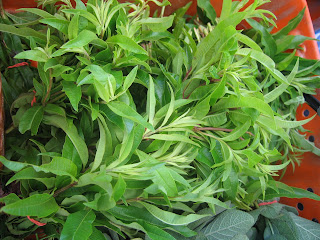 It is fitting the first tomato entry into this chronicle of the season would be for the cherry tomato. Round, oblong or pear-shape these petite gems come to market first, and start to satisfy my need (and I mean need) for sweet, juicy tomatoes. After, a year of mealy, flat red orbs showing up in the kitchen I require the reassurance that all is okay. As with any tomato I will never refrigerate them nor will I ever buy a tomato that comes from afar when in the yard is a vine dangling with the jewel of the summer.
It is fitting the first tomato entry into this chronicle of the season would be for the cherry tomato. Round, oblong or pear-shape these petite gems come to market first, and start to satisfy my need (and I mean need) for sweet, juicy tomatoes. After, a year of mealy, flat red orbs showing up in the kitchen I require the reassurance that all is okay. As with any tomato I will never refrigerate them nor will I ever buy a tomato that comes from afar when in the yard is a vine dangling with the jewel of the summer. In the farmer’s market there is a myriad of colors and sizes to play with try a Sunkist or cherry Cherokee. It does not matter they are all interchangeable, and most definitely put in their place those prefect specimens we suffer all winter truly have no place on our plate.

Black Eyed Peas and Cherry Tomatoes - yields 8 serving
1-1/2 cups black-eyed peas - soaked overnight
3 leeks - whites only, washed and blanched
1/2 cup garlic chives - chopped
2 heaping tablespoon Dijon mustard
2 pints cherry tomatoes
1/2 cup chopped Italian parsley - leaves only
2 tablespoons Balsamic vinegar
Salt and black pepper to taste
In a one quart pan cook the beans completely covered in water over a simmering heat for approximately 40 minutes. Drain the peas, and while they are still hot toss with the ingredients, save the Balsamic vinegar. Let the mixture sit for 10 minutes, and then add the vinegar. By letting the mixture sit you are allowing the mustard to infuse its flavor into the warm peas without getting lost in the vinegar. Enjoy this dish hot or cold.
Red and Yellow Marble Salad - yields 8 servings
1/4 pound baby red potatoes
1/4 pound baby Yukon gold potatoes
1/2 cup extra virgin olive oil
1 pint red cherry tomato - halved
1 pint yellow cherry tomato - halved
1 green chili - diced ( such as jalapñeo or serrano)
1/8 cup champagne Vinegar or White Wine Vinegar
1 lime - zested and juiced
1 cup tightly packed Arugula leaves - roughly chopped
Salt and black pepper to taste
Pre heat the oven to 375 degrees.
Toss the potatoes with the oil and place on a baking tray. Cook the potatoes in the oven for 20 to 25 minutes until tender and slightly blistered.
With the potatoes still warm gently toss together with all the remaining ingredients in a bowl. Refrigerate 2 hours before serving.



































